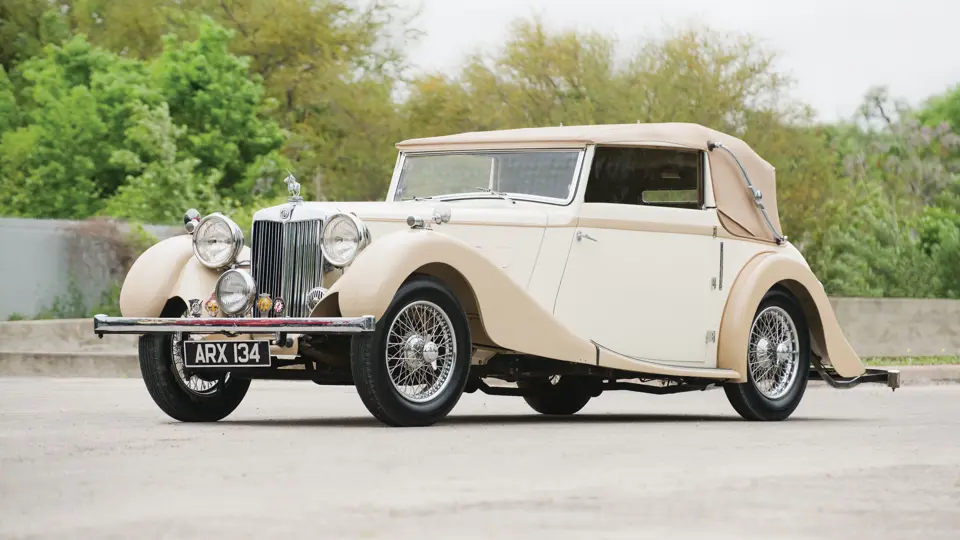 | Auburn, Indiana
| Auburn, Indiana
2,322-cc, 75-hp, overhead valve inline six-cylinder engine, four-speed manual transmission, semi-elliptic rear springs, four-wheel Lockheed hydraulic brakes with 12-inch drums. Wheelbase: 123-inches
Cecil Kimber had approached the coachwork firm of Mulliners before Lord Nuffield (William Morris) had sold MG and Wolseley to Morris Motors Limited. The reorganization took place under the direction of Leonard Lord, with the resulting prototype and subsequent SA being very similar in appearance and design.
The chassis design was from Cowley and incorporated many standardized parts from Wolseley and Morris cars, yet the overall length of the frame far exceeded anything being produced by the parent company. The fitting of four-wheel Lockheed hydraulic brakes in 1935 was not only a first for MG, but a much needed improvement. The suspension consisted of semi-elliptic rear springs and lever-arm hydraulic shock absorbers front and rear, and a Jackall hydraulic jacking system was fitted as standard equipment. As for chassis lubrication, it was accessed via nipples grouped under the bonnet.
The original Morris-based inline six-cylinder engine was rated at 67 brake horsepower, but this engine was subsequently enlarged to 2,288 cubic centimeters, then again to 2,322-cc and a rated 75-hp, to keep up with competition.
In addition to a four-door saloon, a Tickford version was promised. This two-door was fitted with a three-position hood (top), which gave owners choice of fully open, closed or de ville style motoring. A winding mechanism was used to open and close the hood, from which originated the term Tickford. It was only later that the name became associated with the Drophead body style or as the name for the coachbuilder.
The coach building firm responsible for the three-position top were Salmons and Sons Ltd., who were well-known for their quality coachwork as well as their ability to create a ‘smart appearance’ whether the easy-to-fold Tickford top was erect or folded.
The stylish 1937 MG SA Tickford Three-Position Drophead Coupe presented here originally left the MG Abingdon factory September 23, 1937 as a standard full-fendered four-door Saloon. It had engine QPHG 2301 and a stately black exterior with a blue leather interior. It was registered in the UK on October 4, 1937 at Berkshire County Council Registrations department and was given registration number ARX 134, which it continues to bear.
In 1990, the sedan body was removed during a complete restoration and replaced by a two-door Tickford body, vigilantly designed by MG specialist Peter Ratcliffe under the guidance of Mr. Ponder.
Painted in a charming tan and cream two-tone color combination, and although the paint shows some blisters and minor crazing, the car still conveys the elegance and flowing lines of a stylish 1930s SA Drophead Coupe. The paint was executed in the style and the colors of “The Great Gatsby”. Under the long hood, the fully detailed engine, with its highly polished twin carburetors, exhibits only minimum wear. Additionally, an extensive toolkit is part of the cowl. The MG is reported to be a fit running example in every respect and will delight its next owners in comfort and style.
Inside, the perfectly matching tan and cream leather upholstery and Wilton carpets add style to the cozy interior, while the matching tan cloth top when erect provides a comfortable environment inside and a dignified statement outside. When positioned behind the factory painted steering wheel, the driver is presented with a restored wooden dash with refinished gold gauges, as well as a commanding view of the road, past the long sporting hood and enthusiastic chrome-plated polo player radiator cap.





